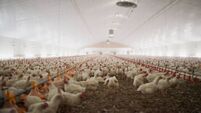The silage decisions you need to make ahead of this year's first-cut

Cows and cattle will consume more top-quality silage, and that will make their rumens healthier and work more efficiently.
As we are now in April, in any normal year, silage season should be just around the corner. But with the wet March there has been very little fertiliser out for silage, so the assumption must be that silage will or should be much later this year.
Producing silage must now be a priority, and striving for quality must still be the aim. This message does not change as quality silage is cheaper to balance and gives better animal performance.
Speaking to farmers over recent weeks, they are becoming more open to the idea of going for three cuts of good-quality silage to fill the pits rather than two heavy cuts of poor fodder. But this must begin by taking the plunge and cutting the first cut early.
When most farmers are advised to cut their silage early, they often say it is bad value as the contractor charges per acre, so each tonne harvested will cost more.
Yes, each tonne will cost more, but each tonne will also produce more milk or weight gain. This will mean that lower levels of concentrates are required to get the same performance.
Cows and cattle will consume more top-quality silage, and that will make their rumens healthier and work more efficiently. By cutting quality swards of grass earlier, each UFL of energy ensiled and utilised by your stock is costing you less, meaning you reduce your production costs.
In order to make your first cut silage earlier, you must make a plan to do so. This must involve an appropriate fertiliser plan which allows you to cut early.
If you apply too much nitrogen and we don’t get appropriate growth rates, then it will not have grown out of the crop on the day you had intended to cut.
Every day beyond that planned date will result in as much as 0.5 Dry Matter Digestibility of a drop per day.
In recent weeks, we have seen a lot of issues on beef and dairy farms around mycotoxins and their detrimental effect on animal performance, and in the vast majority of cases, this has been as a result of poorly ensiled grass silage.
Visible soil contamination in pits and bales is a recipe for problems. We really must look at how we mow, rake, ted, gather and put our silage in the pit. Most don’t get around to rolling their silage ground these days, mainly due to scale and time constraints.
We all need to have a serious conversation with our contractors about mower height, rake height and, most importantly, how the silage is put into our pits.
I must admit that I prefer to see silage mowed on the flat and gathered in just before being picked up. I am also a big fan of mergers and from what silage I have tested where a merger, rather than a rake has been used the ash content has been lower.
If grass is dry standing pre-mowing then it definitely should not be tedded out as it will over-dry.
Silage to be consolidated properly must be put up in shallow layers of inches rather than feet at a time, and it must be compacted constantly.
It must also be in the pit within 24 hours of being mowed and less, if already very dry, if we want to minimise the growth of detrimental bugs in the grass.
Now, we must also look at ourselves and where we are putting our silage! Walled pits make consolidation easier, however, too many yards are now putting twice as much silage in pits than they were originally built for and are going way above the walls, which leads to rotten shoulders and top surfaces.
Grass silage production is getting more and more expensive every year, but we must make enough of it.
Recent years have taught us that we must make sure that we produce more silage than our requirements. Build in a 20-25% safety valve to provide for a longer winter due to poor weather, poor growth etc. Calculate requirements for next winter ASAP.
Remember that you will reduce the tonnage of silage you produce if you cut earlier than you traditionally would. As I mentioned earlier, this tactic will ultimately reduce your overall production costs next winter. Little and often will give you volume and quality.
If you are struggling for acres or good quality swards, should you consider maize silage, beet or whole crop as better value per unit of energy as better value alternatives? This is particularly true if you are producing grass silage on rented ground.
- Brian Reidy is an independent ruminant nutritionist at Premier Farm Nutrition.












